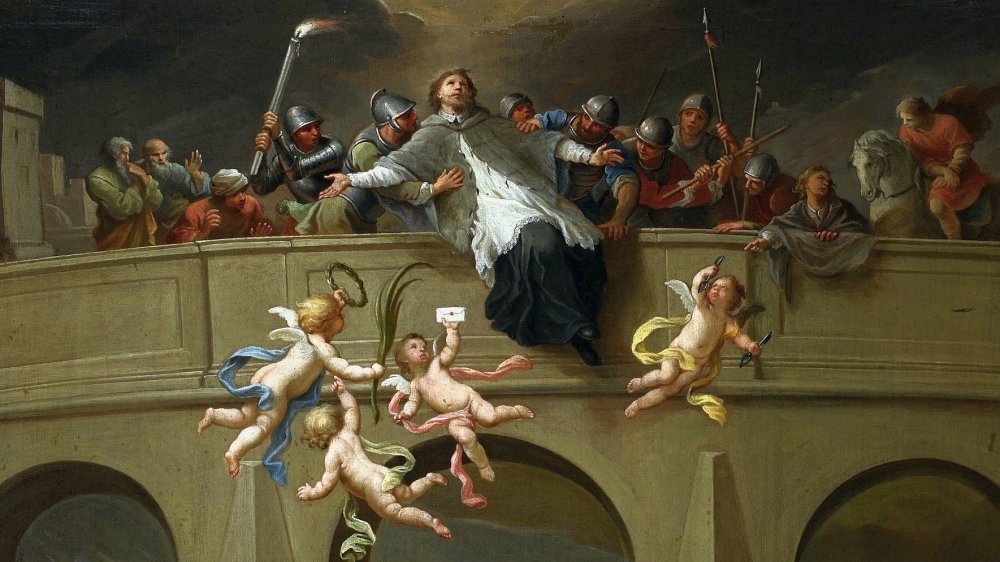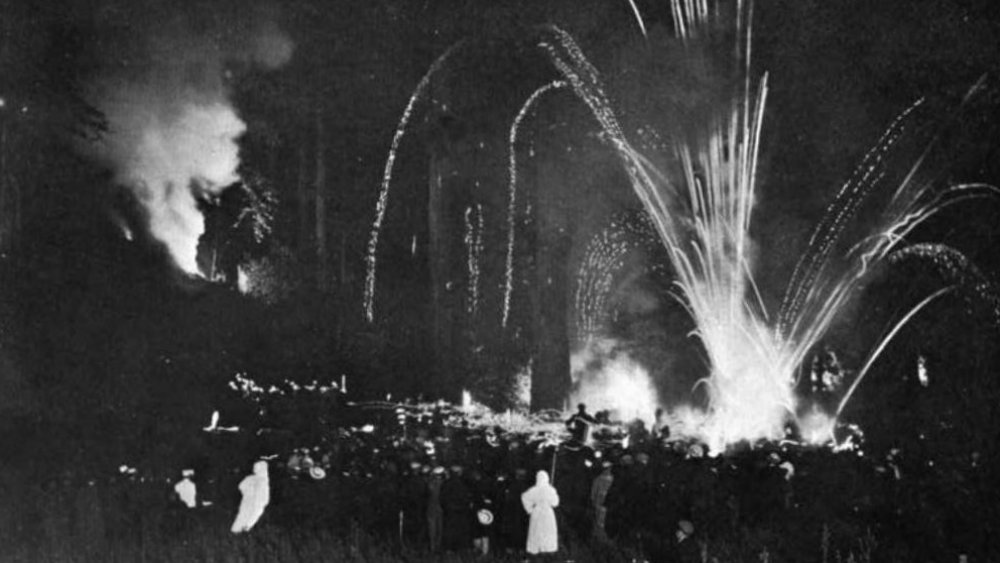What You Didn't Know About The Saint Of Bohemian Grove
The story of the Bohemian Grove constitutes one of the greatest epics in modern, global conspiracy making. From British photographer Jack Latham's book Parliament of Owls, to absolute lunatic Alex Jones's two-hours-plus-long infiltration DVD Darkest Secrets: Inside Bohemian Grove, the Order of Death, the Grove has captured the imagination of the public. It's easy to see why: a by-invitation-only, members-only club of CEOs, politicians, artists, financiers and so on, in Sonoma County, California, where folks literally dress up in druidic costumes and burn effigies and recite some chants to the Canaanite god Moloch at a ceremony dubbed "Cremation of Care"? Say what?
At the very least, those who visit Bohemian Grove might engage in some offhand discussion about politics and economics, especially if they're people like actual members Clint Eastwood, Henry Kissinger, Richard Nixon, Ronald Reagan, and Mark Twain, as described in Britannica. And it also makes sense that the $25,000 initiation fee, plus yearly dues, isn't something that everyone can afford, so we're looking at an inherent separation of elite vs. plebes, sure. But to expand on these basic facts, and conflate the Bohemian Club, founded in 1872, with a global conspiracy of dominance and control? Maybe a stretch, especially since those who attend seem interested in very little other than drinking, as one service worker described on Gawker.
But what of the so-called "Saint of Bohemian Grove"? Well, strap in, because we've got to dive into a 1,500-year history to help separate fact from fiction.
Enter St. Nepomuk of Bohemia
The moniker "Saint of Bohemian Grove" might conjure imagery of a Grand Poobah-type of coronation where one of the grove's frat-bro elitists is hefted aloft in a chair like C3PO at the end of Return of the Jedi – except wearing moose antlers. In reality, the "Saint" of Bohemian Grove is an actual Catholic saint, St. John of Nepomuk, born in 1393 in Prague, per his biographical entry at Britannica. St. Nepomuk was martyred by King Wenceslas IV of Bohemia — tortured by fire and chucked in a river wrapped in goatskin. Nepomuk even has a UNESCO World Heritage Site in his honor in Moravia, Czech Republic.
The Czech Republic, of course, is the historical capitol of Bohemia, a central European nation spanning back to 5th Century BCE Slavic Czechs, and was a part of the Holy Roman Empire until the empire was dissolved in 1806, also described on Britannica. At that time Bohemia was absorbed into the Austrian Empire, which – again, Britannica – previously held ownership over Bohemia and Hungary during the 1400s under the Habsburg dynasty. The Habsburgs intermarried and intermingled throughout Europe for centuries under the creepy motto A.E.I.O.U.: Austriae est imperare orbi universo ("Austria is destined to rule the world"). Their empire lasted all the way until the end of World War I, which kicked off when heir-apparent to the Austro-Hungarian throne Franz Ferdinand was assassinated.
So now that all that's been cleared up, it's time to get truly conspiratorial.
The lineage of the Habsburgs ... or Hapsburgs
Jason Colavito, on his (let's say "alternative history") website, cites the connection between the Habsburg dynasty and Freemasonry. For anyone who is remotely versed in conspiracy theories, the Freemasons, as discussed on History, constitute some of richest fodder for dot-connecting, along with nigh mythical organizations like the Knights Templar, the Illuminati, and the Bilderberg Group.
This connection alone may be enough for some to use St. John of Nepomuk to bridge the gap between those who attend the Bohemian Club's summer shindigs and conspiracies among the world's financial and political elite. It's important to note that Colavito regards some "ahistorical" conspiracy theories with disdain, refuting the notion that "the Habsburg dynasty ... is the direct lineage of the Merovingian bloodline ... reputed to be the family of the Holy Grail offspring of Mary Magdalene." (For further reading, check out The Da Vinci Code. Or Google.) To compound things, the Washington Post reported in 2018 that former FBI director Robert Mueller accused Paul Manafort and Rick Gates, who worked for President Trump's campaign, of meddling with foreign politics via offshore bank accounts. The name of the group involved? The "Hapsburg group (with a "p")." And of course, there really is a Habsburg Group: a private equity firm with a vague, creepily platitude-laden website.
In the end, either all of this is pure nonsense and St. Nepomuk is a mere symbolic choice, or there's at least some deeper meaning behind the Saint of Bohemian Grove.


